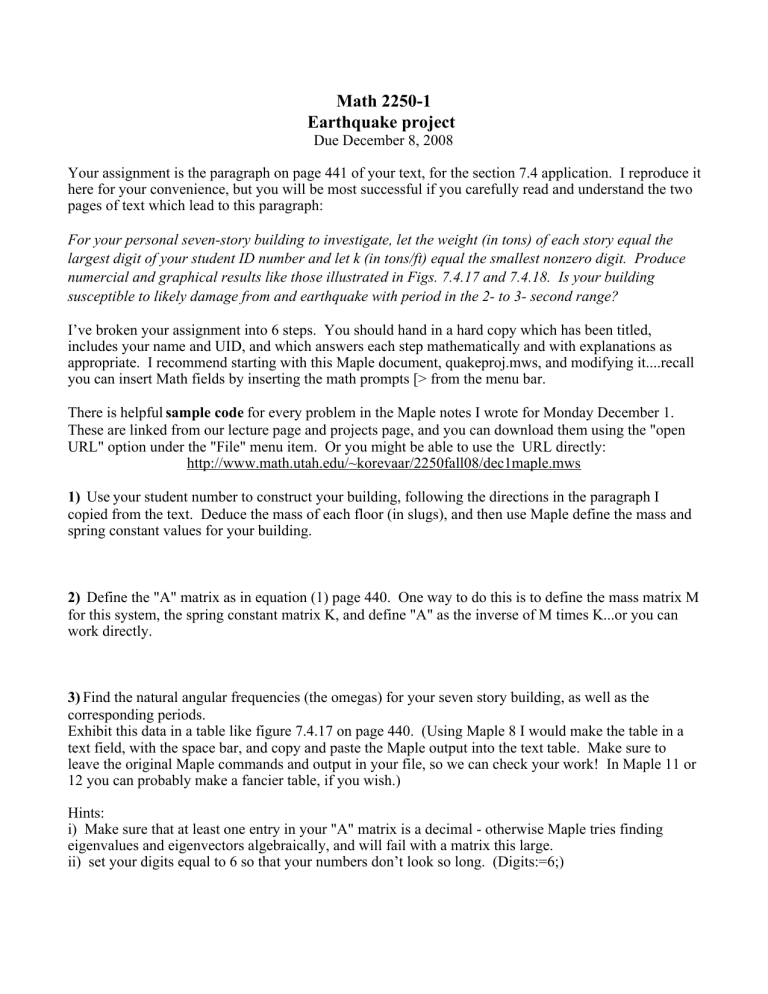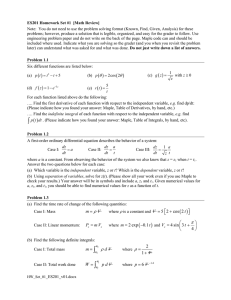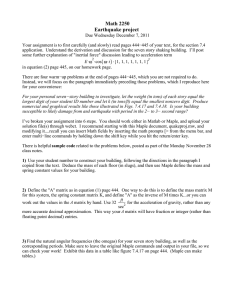Math 2250-1 Earthquake project

Math 2250-1
Earthquake project
Due December 8, 2008
Your assignment is the paragraph on page 441 of your text, for the section 7.4 application. I reproduce it here for your convenience, but you will be most successful if you carefully read and understand the two pages of text which lead to this paragraph:
For your personal seven-story building to investigate, let the weight (in tons) of each story equal the largest digit of your student ID number and let k (in tons/ft) equal the smallest nonzero digit. Produce numercial and graphical results like those illustrated in Figs. 7.4.17 and 7.4.18. Is your building susceptible to likely damage from and earthquake with period in the 2- to 3- second range?
I’ve broken your assignment into 6 steps. You should hand in a hard copy which has been titled, includes your name and UID, and which answers each step mathematically and with explanations as appropriate. I recommend starting with this Maple document, quakeproj.mws, and modifying it....recall you can insert Math fields by inserting the math prompts [> from the menu bar.
There is helpful sample code for every problem in the Maple notes I wrote for Monday December 1.
These are linked from our lecture page and projects page, and you can download them using the "open
URL" option under the "File" menu item. Or you might be able to use the URL directly: http://www.math.utah.edu/~korevaar/2250fall08/dec1maple.mws
1) Use your student number to construct your building, following the directions in the paragraph I copied from the text. Deduce the mass of each floor (in slugs), and then use Maple define the mass and spring constant values for your building.
2) Define the "A" matrix as in equation (1) page 440. One way to do this is to define the mass matrix M for this system, the spring constant matrix K, and define "A" as the inverse of M times K...or you can work directly.
3) Find the natural angular frequencies (the omegas) for your seven story building, as well as the corresponding periods.
Exhibit this data in a table like figure 7.4.17 on page 440. (Using Maple 8 I would make the table in a text field, with the space bar, and copy and paste the Maple output into the text table. Make sure to leave the original Maple commands and output in your file, so we can check your work! In Maple 11 or
12 you can probably make a fancier table, if you wish.)
Hints: i) Make sure that at least one entry in your "A" matrix is a decimal - otherwise Maple tries finding eigenvalues and eigenvectors algebraically, and will fail with a matrix this large.
ii) set your digits equal to 6 so that your numbers don’t look so long. (Digits:=6;)
4) We study approximate resonance as we did in class, i.e. by studying the (undetermined coefficients) particular solution to (2), page 440, for your building. The method is outlined on page 437 of the text, as well as in the class notes from December 1. The Maple commands are in the document referenced at the top of this project. Of course, you will need to understand the commands and derivation and modify them somewhat for this project, since equation (2) on page 440 does not look exactly like equations
(29-30) on page 436. Choose the vector b appropriately in page 440 (2) so that it corresponds to a ground shaking amplitude of 3 inches (as suggested by the warmup problem #4, Find the vector c
(depending on w) so that c *cos(wt) solves (2). Do not display c(w), as it is a big long mess. Notice, the text explains that each entry of b is the same even though the building is only being shaken at the ground level, and says the reason is "intertial forcing." If you want a more mathematical explanation, try the page posted at http://www.math.utah.edu/~korevaar/earthquakecomments.pdf
5) Create an approximate resonance picture like Figure 7.4.18, for your building. Note that in this graph you are to compute the maximal amplitude of the c -vector as a function of period, not of angular frequency.
6) Is your particular building susceptible to likely damage from an earthquake having its period in the 2 to 3 second range? Explain.




